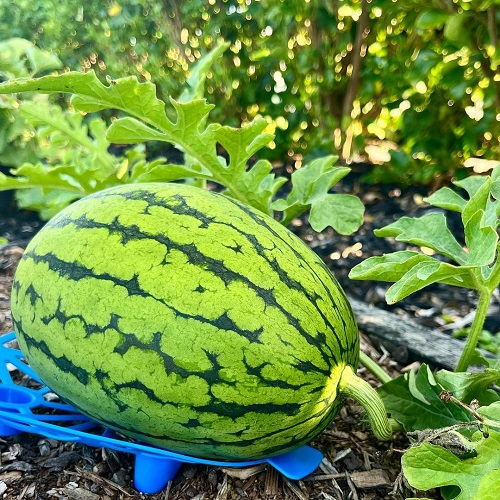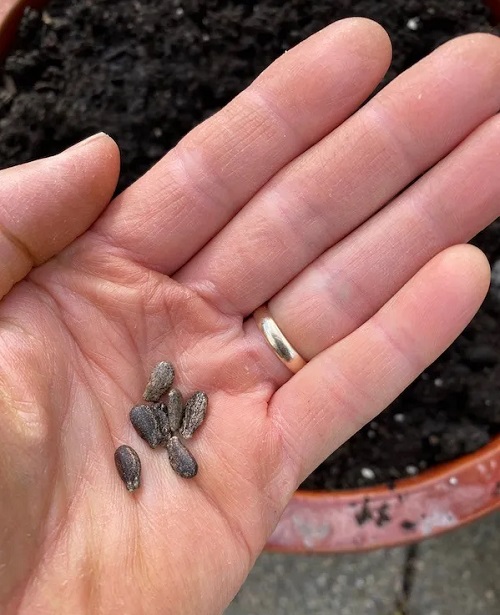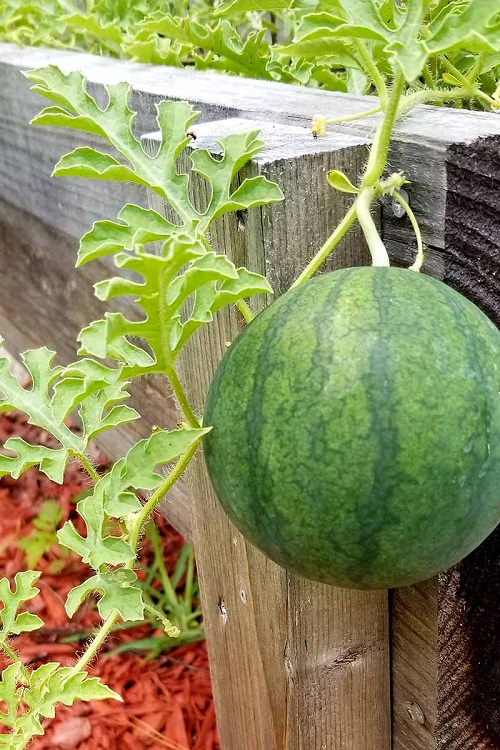Here’s a step by step guide on How to Grow Watermelons from Seeds! Grow them in gardens or pots today!
Follow this expert guide on How to Grow Watermelons from Seeds and learn the best tips and tricks on growing this refreshing fruit!
Here is How to Pick a Good Watermelon
Best Watermelon Varieties to Grow From Seeds
- Crimson Sweet: A classic watermelon variety with deep red, sweet flesh. It has a high sugar content and is known for its excellent flavor.
- Sugar Baby: A compact, early-maturing variety that is perfect for smaller gardens or containers. The flesh is deep red, juicy, and exceptionally sweet.
- Charleston Gray: This heirloom variety is known for its large, oblong fruits with a light green rind. The flesh is juicy, sweet, and refreshing.
- Jubilee: An All-America Selections winner, Jubilee watermelons have a sweet, crisp, and flavorful flesh. It is a popular variety for its high yields and exceptional taste.
- Black Diamond: A classic variety with large, round fruits and a dark green, almost black rind. The flesh is deep red, sweet, and juicy.
- Moon and Stars: This unique watermelon variety stands out for its distinctive yellow spots on the rind. The flesh is typically deep red and exceptionally sweet.
- Sangria: A seedless watermelon variety, it has a crisp texture and sweet flavor. The absence of seeds makes them convenient for eating and using in recipes.
- Crimson Tide: Popular for its disease resistance and high-quality fruit, it has a deep red flesh with a sweet, crisp taste.
Here is How to Grow Black Diamond Watermelon
When to Plant Watermelon Seeds
1. USDA Zones 3-6 (Cold Climate)
In USDA Zones 3-6, which generally cover colder regions of America, watermelon seeds are typically started indoors before being transplanted outdoors. Follow these guidelines:
Begin planting watermelon seeds indoors about 4-6 weeks before the last expected frost date in your area. Use biodegradable pots or seed trays with a seed-starting mix. Place the containers in a warm location with sufficient sunlight or under grow lights.
Once the danger of frost has passed and the soil has warmed up, typically in late spring or early summer, transplant the seedlings into the garden. Ensure that the soil temperature is consistently above 60°F (15.5°C) for successful transplanting. Space the plants according to the variety’s recommendations.
2. USDA Zones 7-9 (Moderate Climate)
In USDA Zones 7-9, which include regions with moderate climates, watermelon seeds can be directly sown outdoors. Follow these guidelines:
Plant watermelon seeds directly in the ground after the last expected frost date has passed and the soil temperature has reached around 70°F (21°C) or higher. This is typically in spring or early summer when the weather has warmed up consistently.
Ensure the soil is well-drained and enriched with organic matter. Sow the seeds according to the recommended spacing for the specific watermelon variety.
3. USDA Zones 9b-11 (Hot Climate)
In these regions, you can start planting watermelon seeds outdoors as early as mid to late winter, usually from mid-February to early March. The precise timing may vary depending on local conditions, but the key factor is to ensure the soil temperature has consistently reached at least 70°F (21°C), as watermelons need warm soil for germination.
In these warmer zones, you might even have the opportunity for two growing cycles. After the initial planting in late winter or early spring, a second planting can take place in midsummer for a fall harvest. This will typically work best in Zones 10 and 11, where temperatures stay warm enough for a longer period.
It’s important to consider local climate conditions, microclimates, and specific weather patterns in your area for precise timing.
Find out if Watermelon is a Fruit or a Vegetable here
How to Grow Watermelon from Seeds
- Select a sunny spot in your garden with well-draining soil. Watermelons thrive in full sun and require plenty of space to spread and grow.
- Work the soil thoroughly, removing any weeds, rocks, or debris. Watermelons prefer slightly acidic soil with a pH of around 6.0 to 6.8. Amend the soil with organic matter, such as compost, to improve fertility and drainage.
- Watermelons can also be directly sown outdoors after the danger of frost has passed and the soil has warmed up to at least 70°F (21°C). Plant the seeds about 1 inch deep in mounds or hills spaced 6-8 feet apart. Plant multiple seeds per mound to increase the chances of successful germination.
- Some watermelon varieties may benefit from trellising or support to keep the fruit off the ground. Install trellises or stakes near the plants when they are still young to avoid damaging the roots later on.
- Keep the soil consistently moist throughout the growing season. Water deeply, providing 1-2 inches of water per week. Avoid overwatering, as it can lead to root rot. Mulching around the plants can help retain soil moisture and prevent weed growth.
- On average, watermelon seeds typically germinate within 6 to 12 days under optimal conditions. Once the seedlings have emerged and developed a few true leaves, thin them to leave the strongest, healthiest plant per mound. Remove weaker seedlings, leaving only one plant per mound.
Learn about growing watermelons in containers vertically here
Growing Watermelon from Seeds in Pot

Choose a pot or container that is at least 12-18 inches in size, with drainage holes at the bottom. A larger container allows for better root development and provides space for the watermelon plant to grow. Do keep in mind that watermelons do not respond well to transplantation because of their taproots.
Look for watermelon varieties specifically bred for container gardening – some of the best ones are:
- ‘Mini Love’: This compact hybrid watermelon produces small, seedless fruits weighing around 5-7 pounds (2.3-3.2 kg). It has a sweet flavor and a crisp texture.
- ‘Bush Sugar Baby’: A dwarf version of the popular ‘Sugar Baby,’ it has a compact growth habit. It produces small fruits with sweet, red flesh.
- ‘Little Baby Flower’: A compact variety, it produces small, round fruits with a sweet flavor.
- ‘Golden Midget’: A unique and compact watermelon variety with small, round fruits. The rind has a golden yellow color when ripe, and the flesh is sweet and juicy.
- ‘Tiger Baby’: It produces small fruits with sweet and juicy flesh.
Have a look at the best yellow watermelons here
Can You Plant Watermelon Seeds Straight From the Fruit
Not all seeds found in a watermelon may be viable or capable of germination. Some seeds may be underdeveloped or damaged, which can affect their ability to sprout and grow into healthy plants. For that, you can do a seed viability test.
Or, you may take a chance by growing multiple seeds.
Note: If you want unique flavors, diverse colors, and shapes, then get Heirloom watermelon seeds and not the Hybrid ones as they are produced by crossing two different varieties of watermelon. When you plant seeds from a fruit of a hybrid watermelon, the plants that grow will not be identical to the parent plant.
Can You Eat Watermelon Seeds
Watermelon seeds are a good source of protein, healthy fats, vitamins, minerals, and dietary fiber. They contain essential nutrients such as magnesium, iron, potassium, and zinc. However, keep in mind that the exact nutritional composition may vary based on the specific variety of watermelon and the seeds themselves.
- Roasted Seeds: Watermelon seeds can be roasted to enhance their flavor and make them more enjoyable to eat. To roast watermelon seeds, remove them from the fruit, rinse them to remove any excess pulp, and pat them dry. Then, spread them on a baking sheet and roast them in the oven at around 325°F (163°C) for about 15-20 minutes or until they turn golden brown. Season them with salt or other desired spices for added flavor.
- Culinary Uses: Roasted watermelon seeds can be enjoyed as a snack on their own, similar to pumpkin seeds or sunflower seeds. They can also be used as a topping for salads, added to trail mixes, or incorporated into baked goods like bread or muffins. Some cuisines use watermelon seeds in traditional recipes or grind them into a paste for various culinary purposes.
- Sprouted Seeds: Watermelon seeds can also be sprouted and used in salads or sandwiches. To sprout watermelon seeds, soak them in water for a few hours or overnight. Then, drain the water and place the seeds in a damp cloth or sprouting tray. Keep them moist and allow them to sprout for a few days until small sprouts emerge. These sprouted seeds can add a crunchy texture and mild flavor to your dishes.




